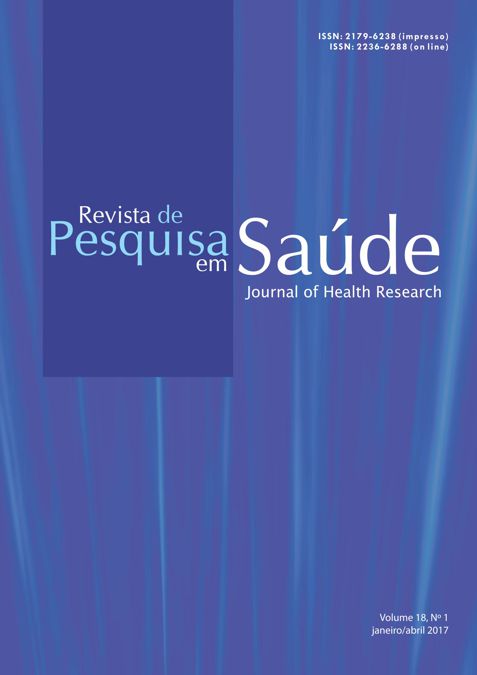AVALIAÇÃO NUTRICIONAL DE PACIENTES COM CÂNCER GÁSTRICO E DE OUTRAS LOCALIZAÇÕES / NUTRITIONAL EVALUATION OF PATIENTS WITH GASTRIC CANCER AND OTHER LOCATIONS
Abstract
Resumo
Introdução: O câncer promove perda de peso progressiva e acentuada. A desnutrição oncológica varia de 40,0% a 80,0%. O
câncer gastrointestinal resulta em diversas complicações nutricionais. Objetivos: Avaliar a prevalência de desnutrição por
diferentes métodos de avaliação nutricional em pacientes com tumores no trato digestivo e em outras localizações. Métodos:
Estudo transversal realizado com 366 pacientes em um hospital referência do município de São Luís (MA). Os dados clínicos,
demográficos e o estado nutricional dos pacientes foram avaliados utilizando-se métodos objetivos (antropométricos) e Avaliação
Subjetiva Global (ASG-PPP escore). Resultados: Dos pacientes avaliados 27,6% tinham tumor no trato digestivo. Houve
prevalência de mulheres (51,7%), procedentes de São Luís (48,1%), com faixa etária acima de 59 anos (45,1%), o tratamento
predominante foi o cirúrgico (27,9%). Apenas a idade se associou estatisticamente (p<0,05) à tumores de outras localizações.
Os pacientes com tumores digestivos apresentaram menor peso (p =0,010) e menor IMC (<0,022) em adultos e idosos
(p<0,001) quando comparados com pacientes com tumores em outras localizações. Dentre os pacientes que foram avaliados
pela ASG-PPP, 63,9% não estavam desnutridos. Dentre os pacientes com tumor digestivo, o maior percentual foi de gravemente
desnutrido (33,8%) segundo a ASG-PPP, e em contrapartida, nos tumores de outras localizações observou se maior percentual
de pacientes com desnutrição moderada (76,6%). Conclusão: O presente estudo identificou a associação do aumento da idade à
tumores de outras localizações, em contrapartida, pacientes com tumores digestivos apresentaram menor peso e IMC.
Palavras-chave: Neoplasias gástricas. Desnutrição. Antropometria. Estado nutricional. Índice de Massa Corporal.
Abstract
Introduction: Cancer causes progressive and acute loss of weight. The cancer malnutrition varies from 40.0% to 0.80%. The
gastrointestinal cancer results in various nutritional complications Objective: To compare the prevalence of malnutrition rates
for different methods of nutritional assessment in patients with and without tumors in the digestive tract in a reference hospital
in Sao Luis, MA. Methods: Cross-sectional study with 366 patients in reference cancer hospital in Sao Luiz cancer - MA. There
was nutritional status through anthropometric methods (weight and BMI) and subjective (ASGPPP). Results: 27.6% had a tumor
in the digestive tract. There was a prevalence of women (51.7%), from São Luiz (48.1%), with age group above 59 years (45.1%),
the predominant treatment was surgery (27.9%). Only age was statistically associated (p <0.05) with tumors from other locations.
Patients with digestive tumors presented lower weight (p = 0.010) and lower BMI (<0.022) in adults and elderly (p <0.001)
when compared to patients with tumors in other locations. Among the patients who were evaluated by ASG-PPP, 63.9% were not
malnourished. Among the patients with digestive tumor, the highest percentage was severely malnourished (33.8%) according
to the ASG-PPP, and in contrast, in the tumors of other locations, a higher percentage of patients with moderate malnutrition
(76.6%) were observed. Conclusion: The present study identified the association of increased age to tumors from other locations,
in contrast, patients with digestive tumors presented lower weight and BMI.
Keywords: Stomach Neoplasms. Malnutrition. Anthropometry. Nutritional status. Body Mass Index.
Downloads
Downloads
Published
How to Cite
Issue
Section
License
Direitos autorais Revista de Pesquisa em Saúde
Este obra está licenciado com uma Licença Creative Commons Atribuição-NãoComercial-SemDerivações 4.0 Internacional.







